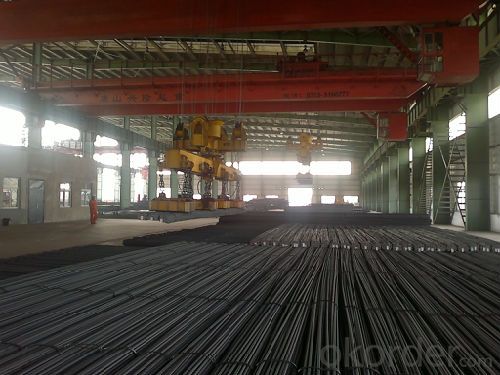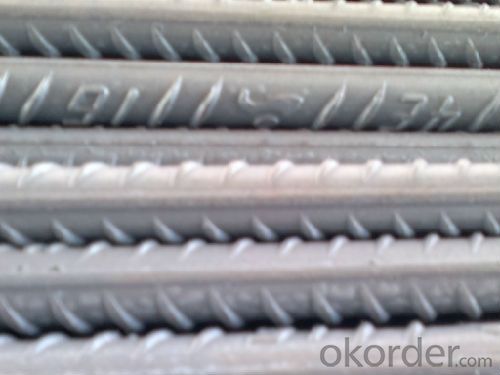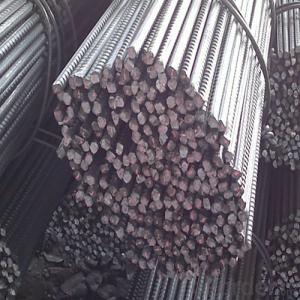HoT Rolled Deformed D-BAR SD400 HRB400
- Loading Port:
- Tianjin
- Payment Terms:
- TT or LC
- Min Order Qty:
- 50 m.t.
- Supply Capability:
- 50000 m.t./month
OKorder Service Pledge
OKorder Financial Service
You Might Also Like
Product Description:
OKorder is offering HoT Rolled Deformed D-BAR SD400 HRB400 at great prices with worldwide shipping. Our supplier is a world-class manufacturer of steel, with our products utilized the world over. OKorder annually supplies products to European, North American and Asian markets. We provide quotations within 24 hours of receiving an inquiry and guarantee competitive prices.
Product Applications:
HoT Rolled Deformed D-BAR SD400 HRB400are ideal for structural applications and are widely used in the construction of buildings and bridges, and the manufacturing, petrochemical, and transportation industries.
Product Advantages:
OKorder's HoT Rolled Deformed D-BAR SD400 HRB400 are durable, strong, and resist corrosion.
Main Product Features:
· Premium quality
· Prompt delivery & seaworthy packing (30 days after receiving deposit)
· Corrosion resistance
· Can be recycled and reused
· Mill test certification
· Professional Service
· Competitive pricing
Product Specifications:
Standard | GB | HRB400 | |
Diameter | 6mm,8mm,10mm,12mm,14mm,16mm,18mm,20mm, 22mm,25mm,28mm,32mm,36mm,40mm,50mm | ||
Length | 6M, 9M,12M or as required | ||
Place of origin | Hebei, China mainland | ||
Advantages | exact size, regular package, chemical and mechanical properties are stable. | ||
Type | Hot rolled deformed steel bar | ||
Brand name | DRAGON | ||
Chemical Composition: (Please kindly find our chemistry of our material based on HRB500 as below for your information)
Grade | Technical data of the original chemical composition (%) | ||||||
C | Mn | Si | S | P | V | ||
HRB400 | ≤0.25 | ≤1.60 | ≤0.80 | ≤0.045 | ≤0.045 | 0.04-0.12 | |
Physical capability | |||||||
Yield Strength (N/cm²) | Tensile Strength (N/cm²) | Elongation (%) | |||||
≥400 | ≥570 | ≥14 | |||||
Theoretical weight and section area of each diameter as below for your information:
Diameter(mm) | Section area (mm²) | Mass(kg/m) | Weight of 12m bar(kg) |
6 | 28.27 | 0.222 | 2.664 |
8 | 50.27 | 0.395 | 4.74 |
10 | 78.54 | 0.617 | 7.404 |
12 | 113.1 | 0.888 | 10.656 |
14 | 153.9 | 1.21 | 14.52 |
16 | 201.1 | 1.58 | 18.96 |
18 | 254.5 | 2.00 | 24 |
20 | 314.2 | 2.47 | 29.64 |
22 | 380.1 | 2.98 | 35.76 |
25 | 490.9 | 3.85 | 46.2 |
28 | 615.8 | 4.83 | 57.96 |
32 | 804.2 | 6.31 | 75.72 |
36 | 1018 | 7.99 | 98.88 |
40 | 1257 | 9.87 | 118.44 |
50 | 1964 | 15.42 | 185.04 |
Usage and Applications of HRB400 Deformed Steel Bar:
Deformed bar is widely used in buildings, bridges, roads and other engineering construction. Big to highways, railways, bridges, culverts, tunnels, public facilities such as flood control, dam, small to housing construction, beam, column, wall and the foundation of the plate, deformed bar is an integral structure material. With the development of world economy and the vigorous development of infrastructure construction, real estate, the demand for deformed bar will be larger and larger..
Packaging & Delivery of HRB400 Deformed Steel Bar:
Packaging Detail: products are packed in bundle and then shipped by container or bulk vessel, deformed bar is usually naked strapping delivery, when storing, please pay attention to moisture proof. The performance of rust will produce adverse effect.
Each bundle weight: 2-3MT, or as required
Payment term: TT or L/C
Delivery Detail: within 45 days after received advanced payment or LC.
Label: to be specified by customer, generally, each bundle has 1-2 labels
Trade terms: FOB, CFR, CIF
FAQ:
Q1: Why buy Materials & Equipment from OKorder.com?
A1: All products offered byOKorder.com are carefully selected from China's most reliable manufacturing enterprises. Through its ISO certifications, OKorder.com adheres to the highest standards and a commitment to supply chain safety and customer satisfaction.
Q2: How do we guarantee the quality of our products?
A2: We have established an advanced quality management system which conducts strict quality tests at every step, from raw materials to the final product. At the same time, we provide extensive follow-up service assurances as required.
Q3: How soon can we receive the product after purchase?
A3: Within three days of placing an order, we will begin production. The specific shipping date is dependent upon international and government factors, but is typically 7 to 10 workdays.
Images:


- Q:What are the different types of steel rebars used in tunneling?
- There are typically two types of steel rebars used in tunneling: epoxy-coated rebars and stainless steel rebars. Epoxy-coated rebars are commonly used in tunneling projects to provide corrosion resistance and enhance durability. On the other hand, stainless steel rebars are used in situations where higher corrosion resistance is required, such as in highly acidic or alkaline environments.
- Q:Are steel rebars suitable for use in structures with high resistance to impact?
- Structures with high resistance to impact can generally make use of steel rebars. These rebars, also known as reinforcement bars, are made from steel and are commonly utilized in concrete structures to enhance their strength and durability. Steel possesses high tensile strength and the ability to absorb and distribute impact forces, making it an excellent material for reinforcement. In situations where impact is a concern, like in bridges, highways, or buildings located in earthquake-prone areas, steel rebars perform a critical function by providing additional strength and resistance. By incorporating rebars, the structure becomes capable of withstanding sudden impact loads and preventing catastrophic failures. Furthermore, engineers have the option to choose from various grades and sizes of steel rebars, ensuring that the appropriate type is selected based on the specific requirements of the structure. Higher grade rebars, such as Grade 60 or Grade 75, offer increased strength and ductility, making them particularly suitable for structures with high resistance to impact. It is worth noting that while steel rebars enhance the overall strength and impact resistance of a structure, other factors such as design, construction techniques, and maintenance also play significant roles in ensuring the structure's ability to withstand impact forces. Therefore, taking a comprehensive approach that encompasses all these factors is crucial when designing and constructing structures with high resistance to impact.
- Q:Can steel rebars be used in precast concrete elements?
- Yes, steel rebars can be used in precast concrete elements. Rebars are commonly used to reinforce the concrete and provide additional strength and durability to the precast elements.
- Q:Are steel rebars suitable for use in historical building restoration?
- Steel rebars can be suitable for use in historical building restoration, but careful consideration should be given to the specific requirements of the project and the significance of the building. Steel rebars offer strength, durability, and ease of installation, which can be advantageous in reinforcing and stabilizing historical structures. However, it is important to ensure that the steel rebars do not compromise the original character and integrity of the building. In some cases, historical buildings may have specific preservation guidelines that prohibit or restrict the use of steel rebars. For instance, if the building is listed as a protected monument, the use of steel rebars may be limited to ensure the preservation of its original materials and construction methods. In such instances, alternative reinforcement materials like timber, stone, or even composite materials may be more appropriate. Additionally, it is crucial to consult with preservation experts, architects, and structural engineers who specialize in historical building restoration. They can provide valuable insights and recommendations on the most suitable reinforcement options for the specific project. Their expertise can help strike a balance between the structural needs of the building and the preservation of its historical value. Ultimately, the suitability of steel rebars for use in historical building restoration depends on a thorough assessment of the building's historical significance, the specific requirements of the restoration project, and adherence to preservation guidelines. With careful planning and consideration, steel rebars can be successfully incorporated into the restoration process, ensuring the longevity and stability of the historical structure while preserving its unique heritage.
- Q:What is the manufacturing process of the hot rolled thread steel production line?
- Rebar is a ribbed steel bar, also known as ribbed steel, usually with 2 longitudinal ribs and transverse ribs uniformly distributed along the length. The transverse rib shape is helical, herringbone, crescent 3. Expressed in millimeters of nominal diameter. Nominal diameter of round steel bars of equal diameter equal to the cross section of ribbed bars. The nominal diameter of the steel bar is 8-50 mm, and the recommended diameters are 8, 12, 16, 20, 25, 32 and 40 mm. Ribbed steel bars are mainly subjected to tensile stress in concrete. Because of the function of rib and the greater bonding ability of concrete, ribbed steel bar can bear the effect of external force better. Ribbed steel bars are widely used in a variety of building structures, especially large, heavy, light, thin-walled and high-rise structures.
- Q:What is the role of steel rebars in the construction of sports arenas and stadiums?
- The role of steel rebars in the construction of sports arenas and stadiums is to provide structural reinforcement and strength to the concrete used in the construction process. Steel rebars are embedded within the concrete to enhance its tensile strength and prevent cracking or failure under heavy loads or seismic activity. They help distribute the weight and forces evenly, ensuring the stability and durability of the structure, thereby ensuring the safety of spectators and athletes.
- Q:What factors affect the cost of steel rebars?
- The factors that affect the cost of steel rebars include the price of raw materials such as iron ore and scrap metal, the cost of production and manufacturing processes, transportation and logistics expenses, market demand and supply dynamics, currency exchange rates, and any applicable tariffs or trade policies. Additionally, economic factors such as inflation, interest rates, and overall market conditions can also impact the cost of steel rebars.
- Q:Are steel rebars suitable for use in sports stadiums and arenas?
- Steel rebars are indeed suitable for use in sports stadiums and arenas. They are extensively utilized in construction due to their exceptional strength and durability properties. In settings such as sports stadiums and arenas, where there is a convergence of large crowds, heavy loads, and utmost concern for safety, steel rebars play a vital role in fortifying the structure. They possess the capacity to endure high tensile forces and prevent bending, making them an ideal choice for reinforcing concrete structures within stadiums and arenas. Moreover, steel rebars exhibit a high resistance to fire, which is of utmost importance in these sprawling public spaces. All in all, steel rebars are a dependable and well-established option for reinforcing sports stadiums and arenas, as they effectively provide the necessary support and meet safety requirements.
- Q:What are the advantages of using deformed steel rebars?
- There are several advantages to using deformed steel rebars in construction projects. Firstly, the deformed shape of the rebars provides enhanced bonding with the surrounding concrete. The ridges, bumps, or indentations on the surface of the rebar increase the surface area in contact with the concrete, resulting in improved adhesion. This ensures a stronger bond between the rebar and the concrete, making the overall structure more resistant to forces such as tension, compression, and shear. Secondly, deformed steel rebars offer better resistance to slippage. The irregular surface of the rebar prevents it from easily slipping or moving within the concrete. This is particularly beneficial in structures subject to seismic activity or heavy loads, as it helps to maintain the integrity and stability of the construction. Additionally, the use of deformed steel rebars enhances the overall structural strength and durability of the project. The deformations on the surface of the rebar allow it to better absorb and distribute stress, making it less susceptible to cracking or failure under high loads. This strength and durability make deformed rebars suitable for a wide range of applications, including bridges, high-rise buildings, and industrial structures. Furthermore, deformed steel rebars provide cost-effectiveness in long-term maintenance. The improved bond between the rebar and concrete reduces the risk of corrosion and deterioration over time. This leads to reduced maintenance and repair costs, as the structure remains more resilient and less prone to structural degradation caused by environmental factors. Lastly, deformed steel rebars offer versatility in design. The various types and sizes of deformed rebars available in the market allow engineers and designers to choose the most appropriate option for their specific project requirements. The flexibility in design ensures that the rebars can be tailored to meet the structural demands of different applications, thus contributing to the overall efficiency and safety of the construction project. In conclusion, the advantages of using deformed steel rebars include enhanced bonding with concrete, resistance to slippage, improved structural strength and durability, cost-effectiveness in maintenance, and versatility in design. These advantages make deformed steel rebars a preferred choice in construction projects where strength, stability, and long-term performance are crucial factors.
- Q:Can steel rebars be used in structures with limited maintenance access?
- Yes, steel rebars can be used in structures with limited maintenance access. Steel rebars are commonly used in construction projects because of their durability and strength. They are able to withstand heavy loads and provide reinforcement to concrete structures. In structures with limited maintenance access, steel rebars offer several advantages. Firstly, they have a long lifespan and are resistant to corrosion, which reduces the need for frequent maintenance. Unlike other materials, such as wood or aluminum, steel rebars do not decay or rot over time, making them suitable for structures that are difficult to access for regular maintenance. Additionally, steel rebars can be easily inspected using non-destructive testing methods such as ultrasound or magnetic particle inspection. These techniques can detect any potential defects or damage in the rebars without the need for invasive measures, thus ensuring the structural integrity of the building. Furthermore, steel rebars can be designed and installed in a way that minimizes the need for future maintenance. For example, the use of epoxy-coated rebars can provide an extra layer of protection against corrosion, extending the lifespan of the structure and reducing the need for maintenance. However, it is important to note that although steel rebars are highly durable, they are not completely maintenance-free. Over time, the protective coatings on the rebars may deteriorate, and if not addressed, corrosion can occur. Therefore, periodic inspections and maintenance activities should still be conducted, even in structures with limited access. In conclusion, steel rebars can be used in structures with limited maintenance access due to their durability, resistance to corrosion, and the ability to be inspected without invasive measures. However, regular inspections and maintenance are still necessary to ensure the long-term performance of the rebars and the overall structural integrity of the building.
1. Manufacturer Overview |
|
|---|---|
| Location | |
| Year Established | |
| Annual Output Value | |
| Main Markets | |
| Company Certifications | |
2. Manufacturer Certificates |
|
|---|---|
| a) Certification Name | |
| Range | |
| Reference | |
| Validity Period | |
3. Manufacturer Capability |
|
|---|---|
| a)Trade Capacity | |
| Nearest Port | |
| Export Percentage | |
| No.of Employees in Trade Department | |
| Language Spoken: | |
| b)Factory Information | |
| Factory Size: | |
| No. of Production Lines | |
| Contract Manufacturing | |
| Product Price Range | |
Send your message to us
HoT Rolled Deformed D-BAR SD400 HRB400
- Loading Port:
- Tianjin
- Payment Terms:
- TT or LC
- Min Order Qty:
- 50 m.t.
- Supply Capability:
- 50000 m.t./month
OKorder Service Pledge
OKorder Financial Service
Similar products
New products
Hot products
Related keywords





























